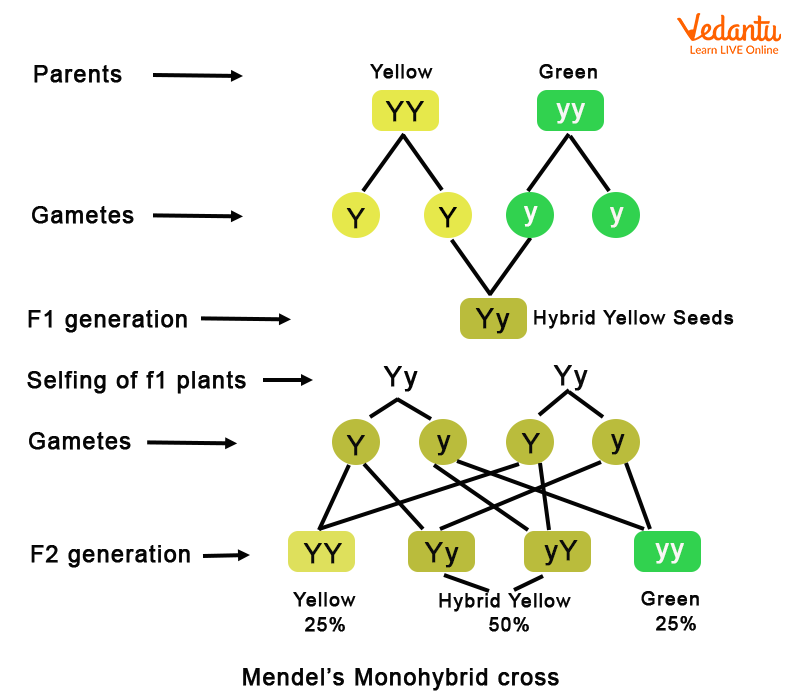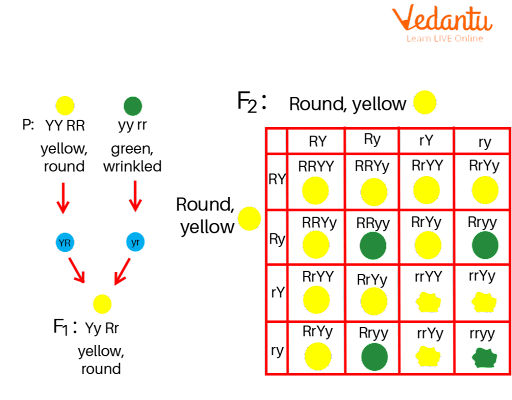How Mendelian Ratio Helps You Solve Genetics Questions
Have you ever thought about why children look similar to their parents? Or sometimes they differ. Gregor Mendel has conducted various experiments such as monohybrid and dihybrid cross and gave three laws of inheritance that explain the inheritance pattern but there are also various exceptions to Mendel's law that do not follow Mendel law.
Mendelism
Mendelism is used to illustrate the principles of inheritance given by Gregor Mendel. These are also known as Mendel's law.
Mendel's Experiment
Mendel conducted several experiments on pea plants for years. He considered seven contrasting traits of pea plants.
A brief explanation of Mendel's experiment is discussed here:
Monohybrid Experiment - In this experiment, Mendel takes two pea plants that have all the same traits except one Such as yellow and green seeds.
First Mendel crossed the two pea plants known as the parent plants and obtained the first filial generation. In the first filial generation, all seeds were yellow in phenotypic appearance.
Then he crossed the first filial generation and obtained the second filial generation in which 75% of seeds were yellow and the remaining 25% of seeds were green.

Monohybrid Cross
Dihybrid Experiment - A Dihybrid cross is a cross between two plants that have all the same traits except two. Two traits are contrasting in nature.
Such as green, and yellow seeds, and round and wrinkled seeds.
First Mendel took two yellow and round, green and wrinkled pea plants, crossed them, and obtained the first filial generation.
All plants in the first filial generation were round and yellow.
Then he again crossed two plants of the first filial generation and obtained the second filial generation. 56% of plants were round and yellow. 18% of plants were yellow and wrinkled, and 18% of plants were green and round whereas 6% of plants were round and wrinkled.

Dihybrid Cross
Mendel's Ratio
Mendel's Law
Mendel's laws are also known as the law of inheritance.
There are three laws of inheritance given by Mendel.
Law of dominance
Law of segregation
Law of Dominance
This is the first law of Mendel. It states that
In heterozygous conditions, one allele dominates the other allele. This means in heterozygous conditions only one allele will express itself over the other.
Law of Segregation
This is the second law of Mendel and it states that when there are two traits in one hybrid pair, the two characters do not mix and each allele segregates independently.
It is a universally accepted law without any exceptions. This law is also known as the purity of gametes.
Law of Independent Assortment
The law of independent assortment states that alleles of two or more different genes get separated into gametes independently of each other.
This means each gamete receives an allele of one gene independent of the allele of another gene.
Deviation From Mendel's Law
There are many deviations from Mendel's law.
Incomplete Dominance - In this, no one allele completely dominates the other allele of a gene in a heterozygous condition. Both alleles express themselves and new phenotypes are formed which are intermediate in both of the alleles. Examples are the pink color of the snapdragon flower.
Codominance - In this both alleles express themselves simultaneously in heterozygous conditions. Examples of codominance are the ABO blood group in humans in which both alleles A and B express themselves.
Multiple Alleles - this condition is present in those genes that have more than two alleles. In this, more than two alternative forms of a gene are present on the homologous chromosomes.
Pleiotropy - is a condition in which one gene affects more than one character or phenotypic trait. It is also known as a qualitative trait
Polygenic Inhertence - this is a condition in which one phenotypic trait is controlled by more than one allele. This is also known as quantitative inheritance. Examples of this type of inheritance are human height or skin color.
Interesting Facts
Mendel was a mathematician who first described genetics.
Mendel took more than seven years to discover and prove the law of inheritance
Mendel's work was rejected initially and didn't bring any recognition or success for him,
Later his work was rediscovered by three scientists and gave him recognition.
Important Questions
1. What is Mendel's famous ratio?
Ans: Mendel's famous ratio is 3:1, for a phenotype for a monohybrid cross.
2. What is the factor in Mendelism?
Ans: Mendel factor is called a gene. Heredity is the result of discrete units of inheritance.
3. What is the meaning of allele?
Ans: Allele is the alternating form of a gene. An individual inherits two alleles, one from each parent.
Practice Questions
Who developed the three main laws of inheritance?
What is the law of inheritance?
What are the three principles of Mendelian genetics?
What cross makes a 1:1:1:1 ratio?
What is universal inheritance?
Key Features
Mendel conducted several experiments on pea plants and concluded his experiments in the form of three laws and tried to explain some concepts of genetics.
Only the Second law of inheritance is followed in every condition and there is an exception to both the first and the third law.
The phenotypic ratio of the monohybrid cross is 3:1 and the genotypic ratio is 1:2:1.
The phenotypic ratio of the dihybrid cross is 9:3:3:1 and the genotypic ratio is 1:2:1:2:4:2:1:2:1.


FAQs on Mendelian Ratio: Key Concepts & Applications
1. What are the classic Mendelian ratios for monohybrid and dihybrid crosses?
The classic Mendelian ratios describe the expected outcomes of genetic crosses based on dominant and recessive alleles.
- For a monohybrid cross (tracking one trait), the typical phenotypic ratio is 3:1 (dominant to recessive), while the genotypic ratio is 1:2:1 (homozygous dominant : heterozygous : homozygous recessive).
- For a dihybrid cross (tracking two independent traits), the typical phenotypic ratio is 9:3:3:1, representing all possible combinations of the dominant and recessive traits.
2. What is the difference between a genotypic ratio and a phenotypic ratio?
The main difference lies in what each ratio describes. A phenotypic ratio refers to the proportion of different observable traits or physical appearances in offspring (e.g., 3 tall plants to 1 short plant). In contrast, a genotypic ratio describes the proportion of different genetic makeups or allele combinations (e.g., 1 TT : 2 Tt : 1 tt).
3. Why were pea plants (Pisum sativum) a good choice for Mendel's experiments?
Mendel's choice of pea plants was crucial for his success because they had several ideal characteristics:
- They have a short life cycle and produce many offspring quickly.
- They show several easily distinguishable, contrasting traits (like flower colour or seed shape).
- The flowers are naturally self-pollinating but can also be easily cross-pollinated, giving Mendel control over his experiments.
- It was easy to obtain pure-breeding lines.
4. What do Mendel's Law of Segregation and Law of Independent Assortment mean?
These are two fundamental principles of heredity discovered by Mendel.
- The Law of Segregation states that during gamete formation, the two alleles for a trait separate from each other, so that each gamete receives only one allele.
- The Law of Independent Assortment states that genes for different traits are sorted separately from one another, meaning the inheritance of one trait does not affect the inheritance of another.
5. What is incomplete dominance and how does it differ from Mendel's observations?
Incomplete dominance is a non-Mendelian inheritance pattern where the heterozygous phenotype is an intermediate blend of the two homozygous phenotypes. For instance, crossing a red-flowered snapdragon (RR) with a white-flowered one (rr) can produce pink-flowered offspring (Rr). This differs from Mendel's classic model, where one allele is completely dominant, and the heterozygote would show the dominant trait, not a new, blended one.
6. How can the Mendelian 9:3:3:1 ratio be modified to a 9:7 ratio?
A 9:7 ratio is a classic example of a modified Mendelian ratio caused by complementary genes. This occurs when two different genes work together to produce a single trait. For the dominant phenotype to be expressed, at least one dominant allele must be present for both genes. If either gene is present only in its homozygous recessive form, the recessive phenotype appears. This interaction groups several genotypes together, resulting in a modified 9 (dominant for both) : 7 (all other combinations) ratio.
7. How does polygenic inheritance explain continuous variation in traits like human skin colour?
Polygenic inheritance is when a single characteristic is controlled by two or more genes. Unlike simple Mendelian traits with distinct categories, polygenic traits show continuous variation. For human skin colour, multiple genes contribute a small, additive effect to the amount of melanin produced. This, combined with environmental factors, results in a wide spectrum of skin tones rather than just two or three distinct options.
8. What is the link between Mendel's laws and the behaviour of chromosomes during meiosis?
The behaviour of chromosomes during meiosis provides a physical basis for Mendel's laws.
- The Law of Segregation is explained by the separation of homologous chromosomes during Anaphase I of meiosis. As chromosomes separate, so do the alleles they carry.
- The Law of Independent Assortment is explained by the random orientation of homologous chromosome pairs at the metaphase plate during Metaphase I. This random alignment ensures that genes on different chromosomes are inherited independently.










